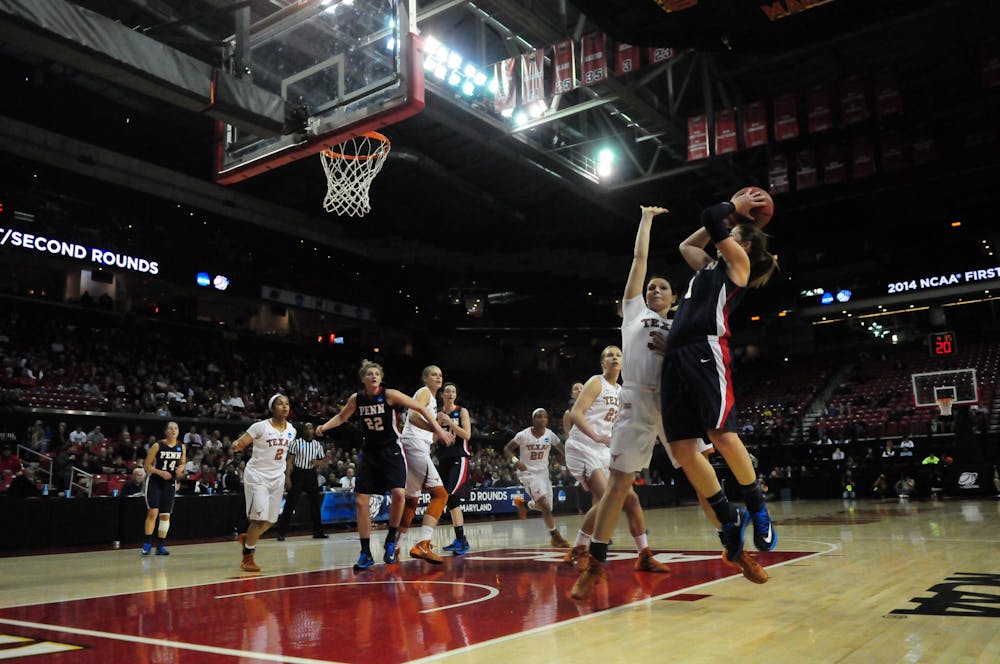Since the NCAA created the NCAA Women’s Basketball Tournament in 1982, schools from the Ivy League have qualified for the tournament 27 times. The Ancient Eight used to send their conference champion to the tournament, but since the introduction of the Ivy League Tournament in 2017, the winner of the tournament has played in March Madness.
The Quakers have represented the Ivy League in the tournament five times in program history, all since 2000. In addition to qualifying for the tournament by winning the conference title four times, the Red and Blue won the inaugural Ivy League Tournament in 2017.
Penn’s first appearance in March Madness occurred in 2001. A team that many consider the greatest in Penn women’s basketball history, the 2001 Quakers were led by all-time great Diana Caramanico. Caramanico was coming off her third straight Ivy League Player of the Year award, in a season in which she averaged 21.7 points and 10 rebounds per game. The 42 points Caramanico notched in a single game that season still stands as a program record.
Caramanico led the Quakers to the Ivy League title for the first time in nearly 20 years, and their first outright championship. The Red and Blue had an undefeated conference record and a 21 game winning streak heading into the tournament. Despite all this, the Quakers rolled into March Madness as a 15th seed, ready to take on the No. 2 Texas Tech Lady Raiders in Birmingham, Alabama. Unfortunately, this storybook season ended with a crushing 100-57 defeat at the hands of a team that made it all the way to the Sweet Sixteen.
The Quakers made the tournament again as a 15th seed three years later, finishing with an 11-3 conference record and winning their second Ivy League Championship. This time, the Quakers were matched up against No. 2 UConn, who were led by future WNBA superstar Diana Taurasi, who had won the Most Outstanding Player award in the preceding year’s tournament. The Huskies were hunting for their third straight championship, but had made the tournament with an at-large bid following a loss in the Big East Tournament. The Quakers were again handed a crushing defeat, losing 91-55 at the hands of the Huskies, who went on to win their third straight championship.
Following a ten year drought, the Quakers returned to March Madness in 2012 as a 12 seed after going 12-2 within the Ivy League. The team's success that year was largely thanks to the play of star freshman Sydney Stipanovich, who won both the Ivy League Rookie of the Year and Defensive Player of the Year awards on the way to her first of three Ivy League Championships. Despite holding a 38-31 lead at the half over the No. 5 Texas Longhorns, the Quakers eventually fell 79-61, dropping to 0-3 in March Madness play in program history.
The Quakers narrowly missed out on a second straight tournament appearance in 2015, finishing second in the conference, but were back in 2016, again led by Stipanovich, who averaged 13 points and 10 rebounds a game. Her outstanding season earned her a third straight Ivy League Defensive Player of the Year award to go along with an Ivy League Player of the Year award, making her the first player to ever to win both awards simultaneously.
The Quakers were seeded tenth, the highest in program history, and were matched up against the seven seed Washington Huskies. The Huskies were led by Naismith Award Semifinalist and the future all-time leading scorer in NCAA Women's Basketball history, junior guard Kelsey Plum. Despite holding the Huskies to just eight first-quarter points and going into halftime with a one-point lead, the Quakers once again collapsed in the second half, and fell to the Huskies 65-53.
RELATED:
How Tony Price took Penn men’s basketball to the Final Four in 1979
Ranking Penn men's basketball's five best March Madness runs of all time
The Quakers most recent tournament appearance occurred the following year, in which the Quakers went 13-1 to earn the one seed in the inaugural Ivy League Tournament, played at the Palestra. Led by Michelle Nwokedi, the Ivy League Player of the Year, the Quakers easily defeated Brown 71-60 and moved on to the finals to face Princeton. Led by a strong defensive effort and the excellent play of Nwokedi, the Quakers defeated the Tigers and moved on to the NCAA tournament for the third time in four years. There, the Quakers were a 12 seed, and matched up with five seeded Texas A&M.
As usual, the Quakers jumped out to an early lead, but this time, they held on beyond the half, going into the fourth quarter with a 21-point lead. It seemed that the Quakers were finally going to win an NCAA tournament game, but Texas A&M switched to a full court press while down 58-37 with eight minutes to play. The suffocating defense caused the Quakers to go ice-cold, missing their final ten shots en route to a 63-61 loss. The Aggies had completed the greatest comeback in NCAA tournament history, and the Quakers were again sent home.
Even though the Quakers made the finals of the next two Ivy League Tournaments, they fell to Princeton both times. The two teams were set up for a fourth straight tournament finals matchup as the one and two seeds in the 2020 tournament, before the pandemic forced the tournament to be canceled.
Although the Quakers' streak of seven straight seasons finishing top two in the conference was interrupted this season by the pandemic, they will look to get back on track next season as they continue their quest for the first ever NCAA tournament win in program history.









